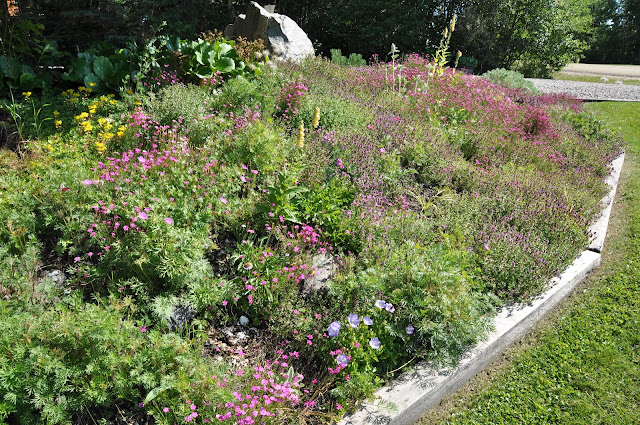The weather is warm, the humidity is 40%, and the colours in the garden are getting more garish in their summer abdunance. The hot pink rose and several varieties of dianthus color the flower beds as the spires of delphiniums rise with their aspirations of impending bloom.
 |
| Large raised bed with pink Sweet Williams in foreground. |
 |
White Campanula persicifolia against
blue Delphiniums |
It is swimming weather in La Ronge, where we don't have any public swimming pools, but do have the lake. If you don't mind the sand in your toes, some weeds in the water, and possibly the occasional leech, it does feel pretty good. Oh yes, and the swimmer's itch parasite lives in a few bays, though that is a pretty common irritant in bodies of water around North America. It also can be prevented by towelling off and changing clothes immediately after getting out of the water.
Speaking of pests, resident-lawnmower-man found our strawberry thief. He watched the squirrel sneak under the carefully placed mesh to get his strawberries and then sneak out again. Some weighty rocks will now be placed on the loose edges of the mesh. What a pest! If our dog was loose, I think we could get rid of that strawberry thief, but alas, we keep the dog contained in a fence.
 |
| Sweet Williams (Dianthus barbatus), a biennial flower that self-propagates very happily. |
 |
| Large raised bed getting full with perennials. The Siberian irises have just finished. |
As far as insect garden pests go, there are some worms in the lettuce and the whole yard is festooned with the little pockets of white spittle bug deposits. If you see wads of "spittle" on your plants, you will find a spittle bug inside. They don't seem too destructive and can be washed off with a stream of water. Otherwise, I sprayed insecticidal soap on the spittle mass that accumulated on the new rose's cluster of new buds.
 |
| Sloped little rock garden full of thyme and Dianthus deltoides, both in bloom. A few yellow perennial foxgloves have popped up here and there. |
 |
| A solitary perennial Geranium flower amid Dianthus deltoides. |
 |
| I love the little mounds of blue and white Campanula carpatica. They get covered in blooms. The burgundy shrub is a Japanese barberry and the silver spikes are Lamb's ears (Stachys byzantina). |
The edibles are growing well, with the pumpkins and other vines finally taking off and looking happy. I don't see any developing fruit on the pumpkins yet, though. The herbs are going to good use in the cooking. Tomorrow will be Mexican food night, so the cilantro will be savoured. Violas are edible too, so this planting below is entirely edible. I put a rosemary in the center, and violas are interplanted with parsley and cilantro, sown from seed in this pot.






















































